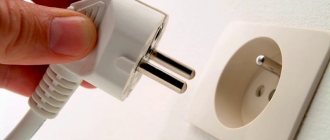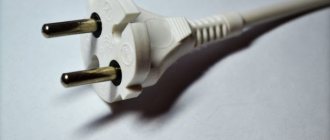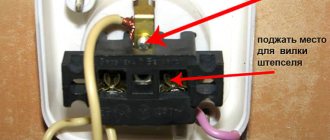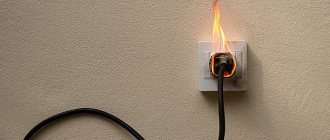What should you do if an outlet in your home periodically starts sparking, especially when you turn the plug on or off? Why is this happening and what does it threaten, let’s take a closer look at the situation. After all, it is quite predictable that such an outlet can melt and ignite, which means there is a risk of fire. There is also a possibility of failure of those household or lighting electrical appliances that you power from it.
Why does the socket spark when connecting electrical appliances?
Causes of sparking in an outlet
There can be several reasons why an outlet sparks. Most often this happens due to:
- different standards of the socket itself and the plug that plugs into it;
- failure of contacts;
- overcurrent;
- problems with poor contact of clamps;
- problems with contact between plugs and sockets;
- low quality installed socket;
- exceeding the rated permissible power value of devices connected to the outlet.
The problem of why an outlet sparks is worth considering in a little more detail for each of these points.
Overcurrent
Excessive current load can cause sparks to appear in the outlet. All sockets are designed for a certain threshold current in the network. Good quality products for larger ones, bad ones for smaller ones. Moreover, it is very important here how long the outlet will be able to withstand the maximum load close to the nominal value.
Overcurrent.
If you plan to connect many appliances or devices to one outlet, then buy one of good quality. There are many well-known companies that produce quality products. Such products are able to withstand loads near the maximum for a long time, without the consequences of failure in the future.
Loose contact connections
The same effect occurs if it is not the connector contact that loosens, but the wire connection. They may not be tightened enough initially, so they will loosen over time, and an area with transient resistance will appear on them. The further process is similar to that described above, with the only difference being that it takes a longer time. It is believed that contacts need to be tightened periodically. But practice shows that with initially high-quality tightening of copper conductors, they will never need to be pulled. But aluminum wires need to be tightened, since they are softer and tend to gradually deform under the action of the mounting screws. Another property of aluminum affects the heating of contacts: when bent, the wire breaks. An inexperienced electrician may not notice this; the wire looks intact, but in some place it is enough to bend it a little for it to break completely. Heating also begins at this point and is transferred to nearby metal parts. As a result, the wire sparks and burns out. That is why the installation of new electrical wiring in residential premises using cables with aluminum conductors is now prohibited.
Loose screw terminals
One of the most dangerous breakdowns when a socket sparks when the plug is turned on or on its own is problems with screw terminals. Such clamps can loosen over time, even on their own. In this case, there will be poor contact on the wires with the socket mechanism. This makes the problem especially acute, since there is a possibility of short circuits and fires, even with minimal load.
Loose screw terminals.
The diameter of the switched wire may become even less than permissible if the socket sparks at the junction of the cable with the terminals. It is better to avoid such a situation.
conclusions
A faulty electrical outlet is a serious problem that needs to be addressed immediately. You can often repair a breakdown yourself, but if you have no experience in handling electrical fittings, it is better to use the help of professionals. Careful handling when turning it on and off and following basic safety rules will help extend its service life.
You can find qualified electricians using the Tandem service. Call the service or leave an online request. The technician will determine why the sockets spark when you plug in the plug and quickly fix the problem.
Connecting enabled devices
This point will be valid regardless of the manufacturer. If the permissible power is exceeded by the sum of the powers of all connected devices and consumers, both the plug and the good quality socket will begin to heat up. The chance of a spark greatly increases, and the situation can develop into a fire hazard.
Connecting enabled devices.
If you connect above the rated power to sockets of poor quality, they will fail very quickly. In general, electrical installation products are not designed for loads higher than the values set by the manufacturer. It is also dangerous for wiring inside walls and inside the house.
Safety
Modern chargers are not just a miniature transformer that reduces the voltage from 220V to 5V.
They have long been smart devices that initially have built-in protection against voltage surges.
Pay attention to the housing of your power supply. You will be surprised, but it is capable of operating in very wide ranges from the 220V standard
In high-quality blocks, the circuit is protected against overheating and short circuits. Such devices themselves are very difficult to burn.
Also, do not forget that today in almost every second apartment it is considered the norm to have a modular voltage relay in the panel board.
Of course, power surges happen here, but in 90% of cases they occur in private homes powered by old power lines.
Moreover, they are made with bare wires, and not with insulated SIP wire.
In urban high-rise buildings, such problems are observed much less frequently. The most likely reason that can burn your charger is a lightning strike on a 10 kV or 0.4 kV power line.
In this case, a short-term pulse of more than 1000 volts passes through the entire 220V electrical network. Even a voltage relay will not save you from it.
The only thing that helps here is the use of other modern devices - SPDs. But for some reason they are much less common among us than the same RCD or UZM.
Now just walk around your apartment and see what you have on 24 hours a day, in addition to charging. This will probably turn out to be:
TV
refrigerator in the kitchen
boiler
microwave
washing machine
But even despite the above-mentioned danger of an overvoltage impulse, you do not pull the plugs of these devices several times a day from the socket blocks.
Then the question is why this needs to be done with cheap charging, which costs tens of times less than everything else.
Moreover, there are also modern wireless chargers.
Here you can order one of the most popular models at an affordable price and with good reviews with free delivery.
Their intended purpose is to be constantly plugged in for your convenience. You throw your phone on this “pancake” at any time, and it charges without any problems.
Nowadays they even produce lockers with wireless chargers built-in.
There are also sockets where there is a USB connector in parallel with 220V.
You can buy similar copies here.
They certainly never turn off and are always energized.
However, we still have to make a reservation here. At the moment, there are a lot of cheap fakes in a wide range.
Inside such devices you will not find high-quality components, much less any smart protection.
These are the types of chargers that 100% need to be pulled out of the sockets. Moreover, it is better to avoid using them altogether. Even at normal voltage, they can burn your phone.
The main danger in them comes from capacitors. If one of them is close to the transformer, it heats up.
This heating subsequently leads to swelling and explosion. The Chinese also save on the copper wire of the transformer itself. As a result, such charges heat up, hum and vibrate.
When vibrating, the turns begin to rub against each other and the layer of insulating varnish is erased. An interturn short circuit occurs.
As a result, the output of the charger is no longer 5V, but 9-12-110, etc. The same capacitors are usually designed for a voltage of 16V and, when overvolted, they jerk so much that the case shatters into small pieces.
That is why such devices should only be purchased in branded stores. When using them, which, by the way, are also made in China, but under completely different conditions and with quality control, you can safely leave the charger in the outlet.
To identify a faulty low-quality product, simply plug the charger into the outlet at idle without the phone. After a few minutes, go up to it and touch the body.
If it gets hot, your charger is most likely faulty. Be sure to turn off such a device; it should not heat up.
Also, it should not beep at idle. This is also an indirect sign of an imminent breakdown.
And to 100% avoid problems during a severe thunderstorm with lightning, turn off not only the power supply of smartphones, but also all other expensive equipment.
Even if your house has lightning protection and lightning rods.
Lightning is still considered an incompletely studied phenomenon. And not a single expert can tell you how to be sure to escape from their side effects.
How to eliminate sparking in an outlet?
If sparking occurs when connecting the plug to the socket. Especially if it is long-lasting, then either repair or complete replacement is needed. During repairs you should do:
- cleaning the contacts at the junction of the wire and the clamp;
- make the wire clamp of high quality;
- cleaning the contacts at the plug connection point;
- also at the junction of the plug with the contacts, the latter should be adjusted so that the fit is tight.
However, in most cases, replacing with a quality outlet will be the best solution. And we recommend using it. For example, LK60 sockets use a special alloy that minimizes the occurrence of sparking. And the dielectric pad will reduce the sparking time to zero, even if it appears when connecting the plug to the contacts, for example, under a heavy load.
Low product quality and wear and tear
The cost of installation products from different manufacturers varies over a wide range. Each product occupies its own price niche: not every buyer is ready to spend money on an expensive socket, switch, plug or lamp. It happens that even well-promoted brands do not meet the expectations of customers: each has its own advantages and disadvantages, and the contact system of sockets is no exception. Particularly influential is the fact that the contacts of the plug connector are structurally made in one piece with the contact for connecting the supply conductor. When you tighten it, you can deform the connector; the plug will come into contact with it not with the entire plane, but with part of it. At small loads this will not be noticeable, but at high currents heating of the contact is inevitable.
The socket connector must withstand repeated plug connections, as well as its long-term presence in it without changing its properties. In practice, the contacts of a low-quality plug are made of cheaper materials, the springing properties of which are lost much faster than those of more expensive products. This is why sockets spark when a plug is inserted - a loose contact system, when the pins move in it, periodically loses connection with them. During operation, heat will be released in the place where the contact is loosened, and a heating element that is harmful to it will appear in the outlet. When heated, surfaces become covered with an oxide film, which further increases the contact resistance and increases the temperature. The process inevitably ends with the heated part melting the plastic around itself, it flows inside the connector and sometimes even blocks the plug in it. The plug itself also heats up, sparks, and the hole around it melts. It is no longer possible to use such a product, and sometimes it is not possible.
[ads-pc-1][ads-mob-1]
What to do to avoid breakdown?
The best recipe is to replace old sockets with good new ones. But if you don’t plan to do this, then don’t put a large load on one outlet. It’s better to install a block of several and distribute the load. If you hear the smell of burning plastic or notice heating, stop using it until the problem is resolved.
What to do to avoid breakdown?
Using a problematic power point is strictly not recommended; it must be either replaced or repaired. If repair work does not help, then you should replace it with a high-quality outlet with a rated load of at least 16A and a permissible total power of connected devices of at least 3.8 kW.
Socket sparks due to overload
A socket, like, in principle, any other household appliance, has certain characteristics and parameters. Each product is marked accordingly. For example, a 16 A and 250 Volt outlet can withstand a load of 3.5 kW.
- 6 Amps – 1.3 kW
- 10 Amps – 2.2 kW
- 32 Ampere – 7 kW
Exceeding the maximum permissible loads will lead to overheating of the socket contacts. As a result, they burn and resistance increases. Based on this, we can conclude that a large number of extension cords and overly powerful devices cannot be plugged into one outlet.
Possible consequences
The most serious consequences, especially when using a non-standard plug, is ignition, which means a high chance of fire. Most often, a short circuit occurs, and the automation completely cuts off power to your house or apartment. This will repeat continuously as soon as you use the broken power point.
Constant short circuits can cause network overload, which can lead to the failure of household or computer equipment. A poor-quality connection also increases the chance of electric shock. For people with heart health problems, electric shock can be fatal.
The correct solution would be to immediately carry out repairs when a problem is detected, as well as replace the old outlet with a new one of good quality.
Low quality
As I wrote earlier in my article “What You Shouldn’t Save on When Repairing,” electricians do not tolerate purchasing low-quality products. If you are not yet familiar with this material, you can read it at this link.
You can try to save your money on laminate, paint or drywall, but never on electrical fittings or wiring. Such savings will not only lead to possible breakdowns of other household appliances, but will also create a fire hazard in the home. A high-quality product will easily withstand the load indicated on it. Cheap options from unknown manufacturers can even be burned by a vacuum cleaner. It is best to purchase goods from trusted suppliers. I would recommend checking out the range and prices on Yandex Market.











